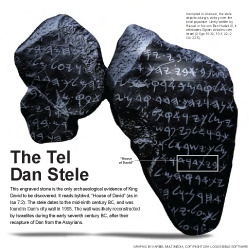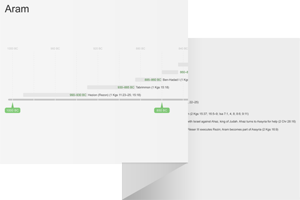13:1 The narrative now moves back in time, to give an account of the Israelite king, Jehoahaz, Jehu’s son (10:35). |
the twenty-third year of Joash Around 814 bc. Jehoahaz reigned over Israel until ca. 798 bc.
13:2 the sins of Jeroboam Refers to syncretism and idolatrous worship. See note on 3:3.
13:3 Hazael king of Aram Elisha had prophesied that Hazael would do evil against Israel (see 8:7–15 and note) and he had already successfully done so (10:32–33; see note on 10:32).
Ben-Hadad This was the name of the king Hazael usurped; Hazael and his son, who adopts this name, were not related by blood to the former Ben-Hadad. Compare note on 6:24.
13:5 Yahweh gave Israel a savior The Hebrew word used here, moshia', often rendered as “savior,” can denote a “deliverer” or “helper.” This seems to refer to Jehoahaz, though a divine figure helping Israel is also a possibility (compare vv. 23; 14:27). This help seems to be a temporary reprieve from warfare, because v. 22 states that Israel was at war with Aram (Syria) all the days of Jehoahaz.
13:6 the pole of the Asherah worship A sacred pole associated with the cult of the Canaanite goddess Asherah. King Ahab was responsible for erecting the Asherah in Samaria (1 Kgs 16:33). Deuteronomy 12:2–4 commands the destruction of high places and Asherah.
King Ahab was responsible for erecting the Asherah in Samaria (1 Kgs 16:33). Deuteronomy 12:2–4 commands the destruction of high places and Asherah.
13:7 as the dust at threshing A common image for vanquishing an enemy (see Isa 28:27; 41:15; Amos 1:3). Threshing involved crushing grain to separate the edible kernels from the husks.
13:8 the events of the days of the kings of Israel See note on 2 Kgs 1:18.
13:9–13 The narrative continues focusing on the nation of Israel by detailing the reign of another king of Israel. This brief passage can be confusing because both Judah and Israel had kings named Joash (yo’ash), which also can be rendered “Jehoash” (yeho’ash)—yeho’ash is an alternate spelling of yo’ash. In v. 9, the Hebrew text uses the spelling yo’ash (Joash) to refer to the king of Israel (who is the son of Jehoahaz). But in v. 10, to distinguish the two kings, the Hebrew text switches to the spelling yeho’ash (Jehoash) for the king of Israel and uses the spelling yo’ash (Joash) for the king of Judah (who is the son of Ahaziah). Starting in v. 12, however, the Hebrew text reverts to the spelling of v. 9 for the king of Israel, calling him yo’ash (Joash) until v. 25. Some English translations resolve this confusion by always calling the king of Israel Jehoash and always referring to the king of Judah as Joash. |
13:9 slept with his ancestors See note on 8:24.
13:10 The narrative here mentions the death of Jehoash (also called Joash), king of Israel, but the narrative about him actually continues until 14:17. |
the thirty-seventh year of Joash king of Judah Around 798 bc.
13:11 the sins of Jeroboam See note on v. 2.
13:13 slept with his ancestors See note on 8:24.
13:14–25 The prophetic service of Elisha (who was introduced in 1 Kgs 19:19–21) lasts nearly half a century. He continues to prophesy while terminally ill, and his bones retain divine power even after his death. |
13:14 the chariot of Israel and its horsemen This is the same cry Elisha uttered when God transported his master, Elijah, to heaven (2 Kgs 2:12).
13:15 Take a bow and arrows Elisha uses a sign-act to prophesy about Israel’s victory. Prophets often used sign-acts to serve as practical examples of how God’s word would be accomplished.
13:17 Aphek The ot mentions several places named Aphek. This one is likely in the Transjordan region, three miles east of the Sea of Galilee. In 1 Kings, Ben-hadad (not to be confused with the Ben-hadad in 8:7–15) and his troops clash with the Israelites and then flee to Aphek, where they suffer defeat (see 1 Kgs 20:1–34).
13:18 three times The number three appears often in ot rituals (e.g., 1 Kgs 17:21). Joash apparently assumes that Elisha meant for him to follow this convention.
13:19 the man of God Refers to Elisha. Compare note on 2 Kings 1:9.
13:20 Moab The Israelites constantly had to repel these neighbors to the east (compare 1:1 and note; 3:5).
the spring The season for war in the ancient Near East (2 Sam 11:1; 1 Kgs 20:22, 26).
13:22 Hazael king of Aram Elisha had prophesied that Hazael would do evil against Israel (2 Kgs 8:7–15 and note).
13:23 covenant with Abraham, Isaac, and Jacob The collective work of 1–2 Kings mentions Israel’s patriarchs only one other time—when Elijah prays to Yahweh during his contest with the prophets of Baal (1 Kgs 18:36).
13:25 Jehoash The Hebrew text here refers to this Israelite king again as yeho’ash (Jehoash), which is an alternate spelling of yo’ash (Joash), which he is otherwise called by in the narrative of 2 Kings 13:12–14:7 (compare note on vv. 9–13).
recovered the towns of Israel The cities Jehoahaz lost must have been west of the Jordan, since Hazael had already taken the territories to the east in the days of Jehu (10:32–33; 12:18). Joash’s victories at Aphek stopped Aram’s (Syria’s) expansion and paved the way for Jeroboam II to reclaim the land (14:23, 25).
Three times A fulfillment of Elisha’s prophecy (v. 19).

|
About Faithlife Study BibleFaithlife Study Bible (FSB) is your guide to the ancient world of the Old and New Testaments, with study notes and articles that draw from a wide range of academic research. FSB helps you learn how to think about interpretation methods and issues so that you can gain a deeper understanding of the text. |
| Copyright |
Copyright 2012 Logos Bible Software. |
| Support Info | fsb |
 Loading…
Loading…


